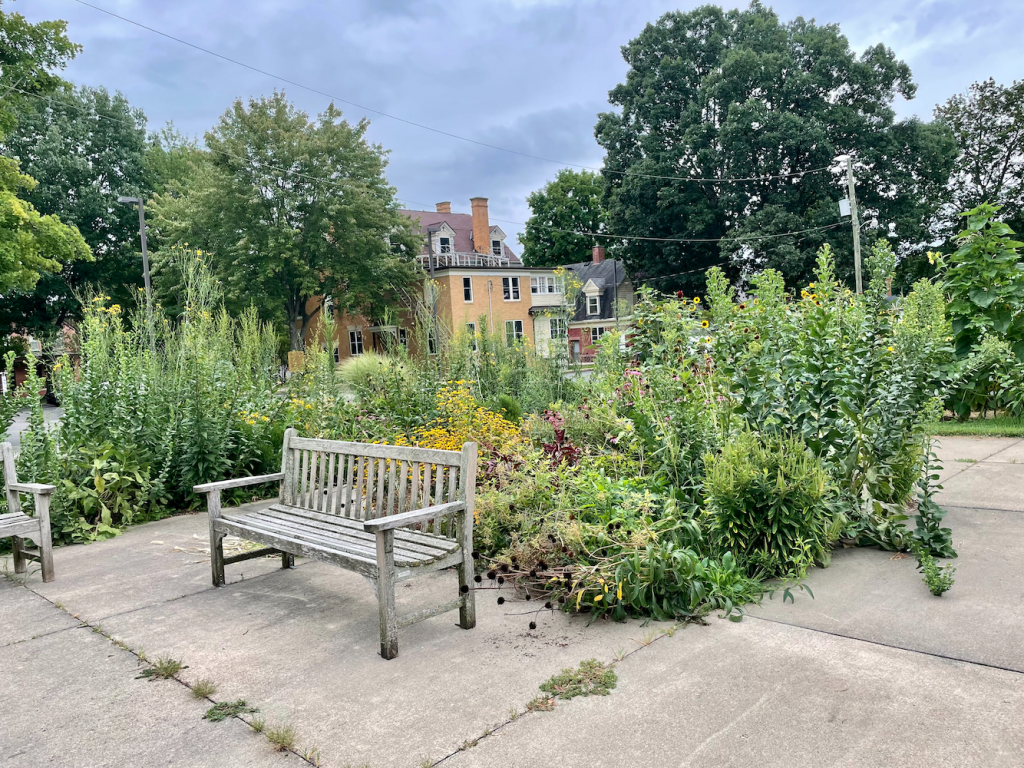
Guide to Local Pollinator Plants
Golden Alexander (Zizia aurea)
Golden Alexander (Zizia aurea) is a perennial that typically blooms in late spring. Usually growing between one and two feet, this species is a part of the carrot family (Apiaceae). Golden Alexander also serves as a host plant for pollinators such as the Black Swallowtail and the Ozark Swallowtail. Golden Alexanders are best identified by their bright yellow umbels (flower clusters). Additionally, the leaves of this plant have feathered edges. Indigenous communities use Golden Alexander roots for tea to help alleviate fevers.
Pollinators:
- Wasps
- Bees (sweat bees, cuckoo bees, yellow-faced bees)
- Flies
- Beetles
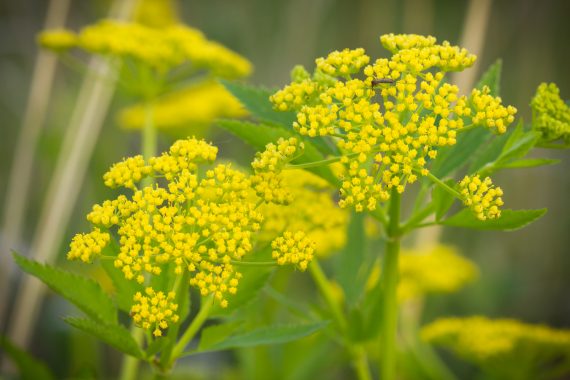
Credit: Justin Meissen (via Wikimedia)
Haiku Poem
Cousin to carrot, your starry blossoms play host to black swallowtails.
Mike Paskus, Z Martin, and Alex Phillips
Pale Purple Coneflower (Echinacea pallida)
Blooming in early summer and reaching up to 3 feet tall, the Pale Purple Coneflower (Echinacea pallida) is a showy flower belonging to the Aster family (Asteraceae). Purple coneflowers are popular among many pollinators including bees, butterflies, and even hummingbirds. Coneflowers are actually composites, made up of many florets (small compact flowers). This means that each petal (ray floret) and each central floret (disc floret) is its own individual flower!
Pollinators:
- Bees
- Butterflies
- Flies
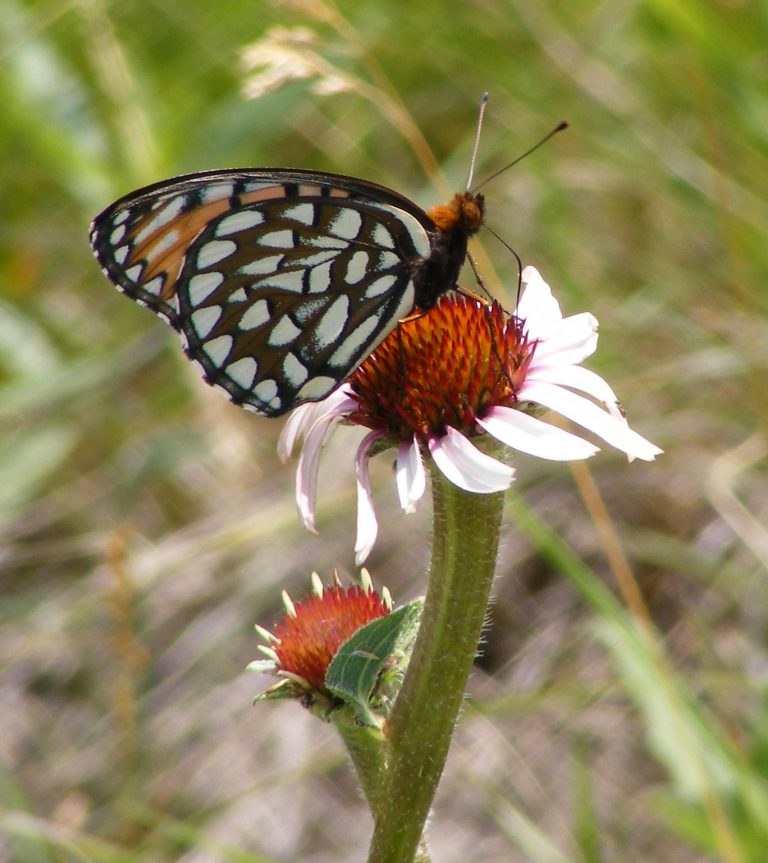
Credit: Laura Hubers (via Wikimedia)
Haiku Poem
Even through long droughts,
Mike Paskus, Z Martin, and Alex Phillips
skipper butterflies find food
in your bristly head.
Smooth Penstemon (Penstemon digitalis)
A perennial that blooms in June and July, Smooth Penstemon (Penstemon digitalis) is also commonly known as Foxglove Beardtongue and Mississippi Beard Tongue. The white, tubular shaped flowers attract pollinators with long tongues like honey bees, bumble bees, and butterflies. Smooth Penstemon also serves as a host plant for the caterpillars of Chalcedon Checkerspot, a species of butterfly.
Pollinators:
- Bees (bumble bee, honey bee)
- Butterflies
- Hummingbirds
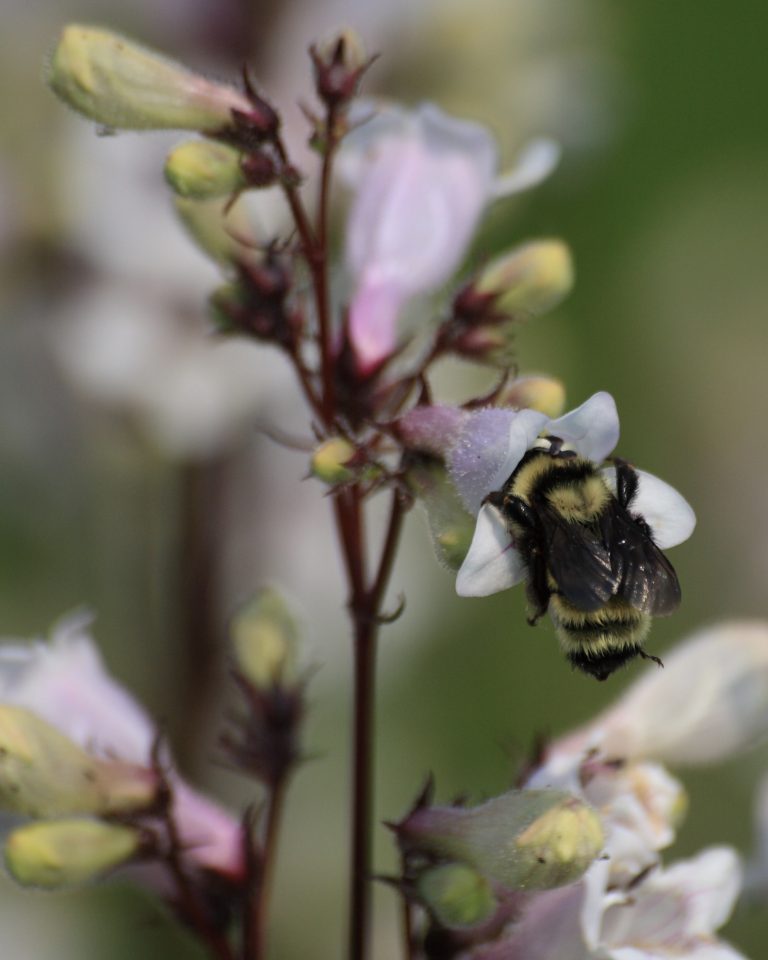
Credit: Sage Ross (via Wikimedia)
Haiku Poem
Like hanging pitchers,
Mike Paskus, Z Martin, and Alex Phillips
your blooms pour sweet nectar for
butterflies and bees.
Ironweed (Vernonia fasciculata)
Deriving its name from its tough stem, Ironweed (Vernonia fasciculata) is popular among many pollinators, especially butterflies. The identifiable bright purple blooms can be found from July all the way through late September. Ironweed is a particularly aggressive spreader by seed and should be planted among other competition. Otherwise, cutting back a few of the flower heads before they seed helps to keep this plant in check.
Pollinators:
- Bees (miner, Cuckoo)
- Butterflies
- Flies (bee flies)
- Beetles
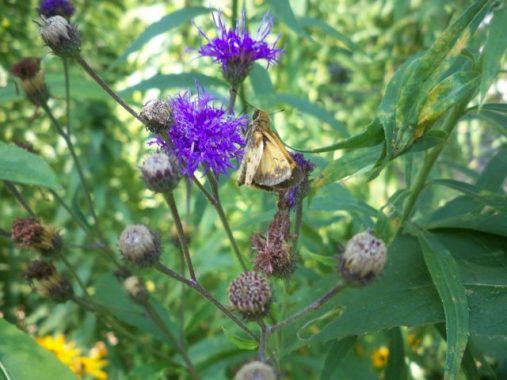
Credit: Emily K. (via Wikimedia)
Haiku Poem
In the late summer,
Mike Paskus, Z Martin, and Alex Phillips
you Vernonia welcome
bees and butterflies.
Rattlesnake Master (Eryngium yuccifolium)
Rattlesnake master is a perennial plant which grows throughout the midwestern United States. Although its prickly-looking gatherings of flowers may remind you of thistle, it’s actually a member of the carrot family (Apiaceae)! These flowers attract many kinds of native pollinators, including soldier beetles, monarch butterflies, and many kinds of bees. Another interesting feature of this plant is its eye-catching name, which likely originates from a disputed claim that Native Americans used its sap to treat snake bites.
Pollinators:
- Bees (yellow-faced, sweat bees)
- Flies
- Wasps
- beetles
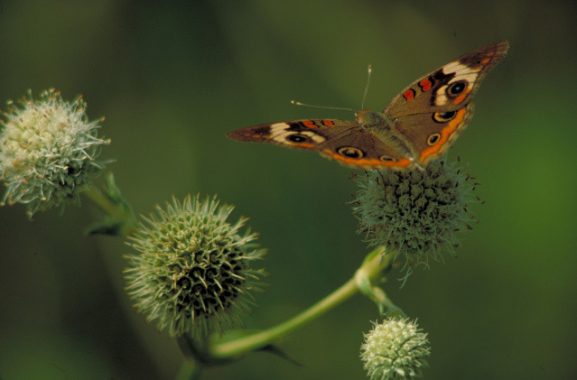
Credit: Dr. Thomas G. Barnes (via Wikimedia)
Haiku Poem
Home to borer moths,
Mike Paskus, Z Martin, and Alex Phillips
your white-roofed inn is a boon
to diversity.
Bergamot (Monarda fistulosa)
Wild Bergamot is a perennial which grows all throughout North America. In late summer, these plants produce bright purple blooms with a delicate fragrance. These blooms attract a number of different pollinators, such as butterflies and hummingbirds. Their structure is also a very useful characteristic for identifying the species: they grow in clusters of many small, purple, tube-shaped flowers. Wild bergamot is also a member of the mint family (Lamiaceae), a relationship that’s easy to understand from their aromatic leaves.
Pollinators:
- Bees (specialist, bumble)
- butterflies
- Hummingbirds

Credit: Emily Greenland
Haiku Poem
Hawkmoths, hummingbirds,
Mike Paskus, Z Martin, and Alex Phillips
and bumblebees sip their fill
from your winged clusters.
Showy Goldenrod (Solidago speciosa)
Showy Goldenrod is a tall, widespread species that you’ve probably seen growing in grasslands or clearings if you’re from the midwestern United States. Their signature golden flowers grow in tall, pyramid-shaped inflorescences at the ends of their often 6-foot-tall stems. Its flowers attract all sorts of pollinators, from bees to butterflies to many kinds of brightly colored beetles. If you’re looking to pollinator-watch in the garden, these golden blooms are a great place to start.
Pollinators:
- Butterflies
- Bees
- Wasps
- flies
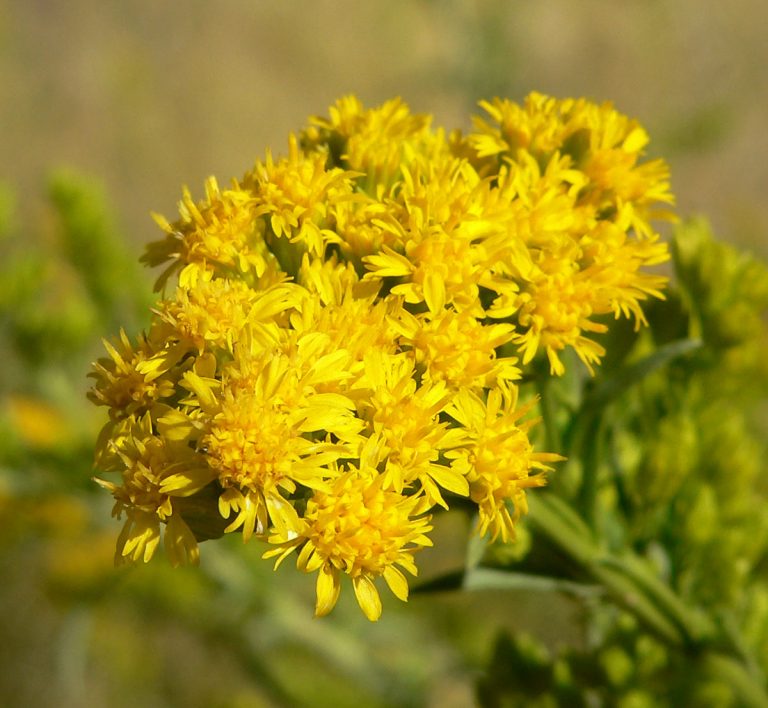
Credit: Stan Shebs (via Wikimedia)
Haiku Poem
Beetles munch pollen
Mike Paskus, Z Martin, and Alex Phillips
while kind solitary wasps
pollinate your fields.
Mountain Mint (Pycnanthemum spp)
Mountain mint is a non-invasive species native to much of North America. Although its leaves may not remind you of the traditional, toothed mint leaves, the fragrant aroma they produce when rubbed will immediately give it away as a member of the mint family (Lamiaceae). The oil that produces this scent, pulegone, is sometimes used as a mosquito repellent. You may have spotted bristly, silvery, flower-like structures at the tops of these plants. These are not actually flowers at all, but bracts (a type of modified leaf)! The true flowers of this plant are held within these bracts, are small and whitish-pink, and are open all throughout the summer months.
Pollinators:
- Butterflies (skippers)
- Bees
- Flies (bee flies)
- Wasps
- Beetles (soldier beetles, locust borer)

Credit: Ashley Arons
Haiku Poem
Fragrant foliage,
Mike Paskus, Z Martin, and Alex Phillips
blue and copper butterflies
flutter through your leaves.
Smooth Aster (Symphyotrichum leave)
Smooth Aster is found all throughout the United States, particularly in the northern regions. It’s easily recognizable by its blue-purple blooms, which are visible throughout the late summer. These blooms are a great representative of one of the more interesting features of the aster family (Asteraceae). At first glance, each ring of purple petals would appear to be surrounding a single flower. But, if you look more closely, you’ll see that the center of the bloom actually contains several tiny flowers! These are called florets, and together they form a unique type of flowering structure called a composite inflorescence. You can see this same type of structure in many other common “flowers”, such as sunflowers and dandelions.
Pollinators:
- Butterflies (skippers)
- Bees (leafcutter, cuckoo, bumble)
- Flies (syrphid flies)

Credit: Adam Kranz (via Wikimedia)
Haiku Poem
Host to many moths,
Mike Paskus, Z Martin, and Alex Phillips
your ray petals soldier on
and glint coldly still.
Whorled Milkweed (Asclepias verticillata)
Native to much of the United States, Whorled Milkweed is a perennial plant which blooms in mid to late summer. Like all milkweeds, its name originates from the whitish milky substance that emerges from their leaves and stems if broken, also known as latex. Its white flowers attract pollinators of all kinds, including several types of butterflies, bees, wasps, and flies. Mammalian herbivores tend to avoid it, however, since it’s a fairly toxic species.
Pollinators:
- Butterflies (Monarch Butterflies)
- Bees
- Hummingbirds
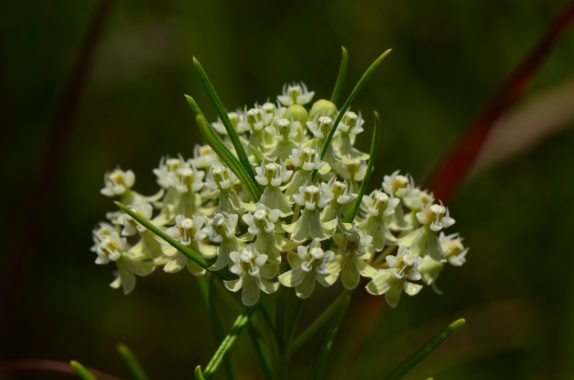
Credit: Joshua Mayer (via Wikimedia)
Haiku Poem
Breeding through your roots,
Mike Paskus, Z Martin, and Alex Phillips
you safeguard generations
of constellations.
Ohio Spiderwort (Tradscantia ohiensis)
The Ohio Spiderwort is, naturally, native to Ohio, as well as much of the midwest. They bloom from the late spring through the middle of the summer, producing their signature three-petaled blossoms with six bright yellow anthers (the parts of the flower which hold the pollen). If you don’t see them blooming right now, and it’s during the blooming period, consider coming back at an earlier hour; these flowers open in the morning and tend to close by the afternoon. The Ohio Spiderwort is often pollinated by bees, like bumblebees, halictine bees, and others.
Pollinators:
- Bumblebee
- Halictine
- Carpenter bees
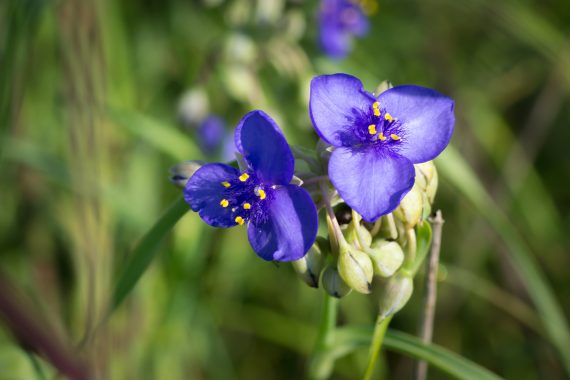
Credit: Andrew Cannizzaro (via Wikimedia)
Haiku Poem
Settler of scorched earth,
Mike Paskus, Z Martin, and Alex Phillips
your broad, purple petals draw
bumblebees and flies.
References
Chayka, K. (2023). Monarda fistulosa (wild bergamot). Minnesota Wildflowers. https://www.minnesotawildflowers.info/flower/wild-bergamot
Crawford, B. (2023). Mountain Mint-Truly, a Gardeners Mint. Mountain Mint-Truly, a Gardeners Mint (Rutgers NJAES). https://njaes.rutgers.edu/plant-of-the-month/pycnanthemum.php
Hilty, J. (2018). Wild bergamot (Monarda fistulosa). Illinois Wild Flowers. http://www.illinoiswildflowers.info/prairie/plantx/wld_bergamotx.htm
Hilty, J. (2023a). Ohio Spiderwort (Tradescantia ohiensis). Illinois Wild Flowers. http://www.illinoiswildflowers.info/prairie/plantx/oh_spiderwortx.htm
Hilty, J. (2023b). Smooth Blue Aster (Symphyotrichum Laeve). Illinois Wild Flowers. https://www.illinoiswildflowers.info/prairie/plantx/sm_asterx.htm
Hilty, J. (2023c). Whorled milkweed (asclepias verticillata). Illinois Wild Flowers. https://www.illinoiswildflowers.info/prairie/plantx/wh_milkweedx.htm
Lady Bird Johnson Wildflower Center. (2023). Plant database- Solidago speciosa. Lady Bird Johnson Wildflower Center . https://www.wildflower.org/plants/result.php?id_plant=SOSP2
Mahr, S. (2023). Rattlesnake Master. Wisconsin Horticulture. https://hort.extension.wisc.edu/articles/rattlesnake-master-eryngium-yuccifolium/#:~:text=The%20common%20name%20“rattlesnake%20master,%2C%20button%20eryngo%2C%20and%20beargrass
Pale Purple Coneflower. Echinacea pallida | Prairie Nursery. (2023). https://www.prairienursery.com/pale-purple-coneflower-echinacea-pallida.html
Prairie Nursery. (2023). Golden Alexanders. Zizia aurea | Prairie Nursery. https://www.prairienursery.com/golden-alexanders-zizia-aurea.html
Prairie Nursery. (2023a). Ironweed Vernonia fasciculata. Vernonia fasciculata Prairie Nursery. https://www.prairienursery.com/ironweed-vernonia-fasciculata.html
Prairie Nursery. (2023b). Smooth Penstemon. Penstemon digitalis | Prairie Nursery. https://www.prairienursery.com/smooth-penstemon-penstemon-digitalis.html
Ulaszek , E., & Benda, C. D. (2023). Rattlesnake Master (Eryngium yuccifolium L.). Forest Service Shield. https://www.fs.usda.gov/wildflowers/plant-of-the-week/Eryngium-yuccifolium.shtml
Disclaimer: Plants listed above are native species that benefit our local pollinators
Contents and Page created by Henry Steinmetz, Sam Foye, and Carolyn Velazquez
Fall 2023 Botany